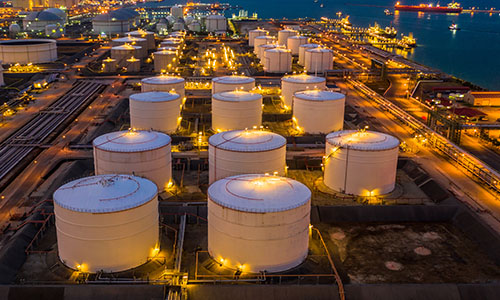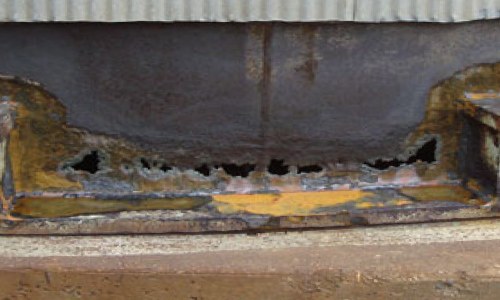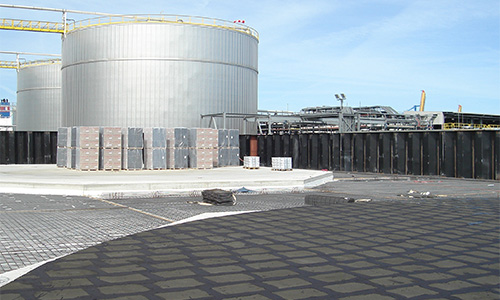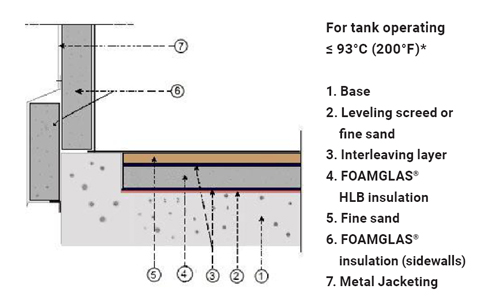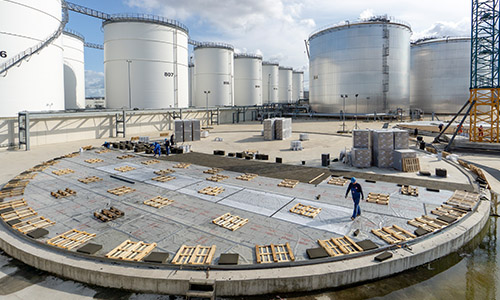Energy and cost savings with hot storage tank base systems
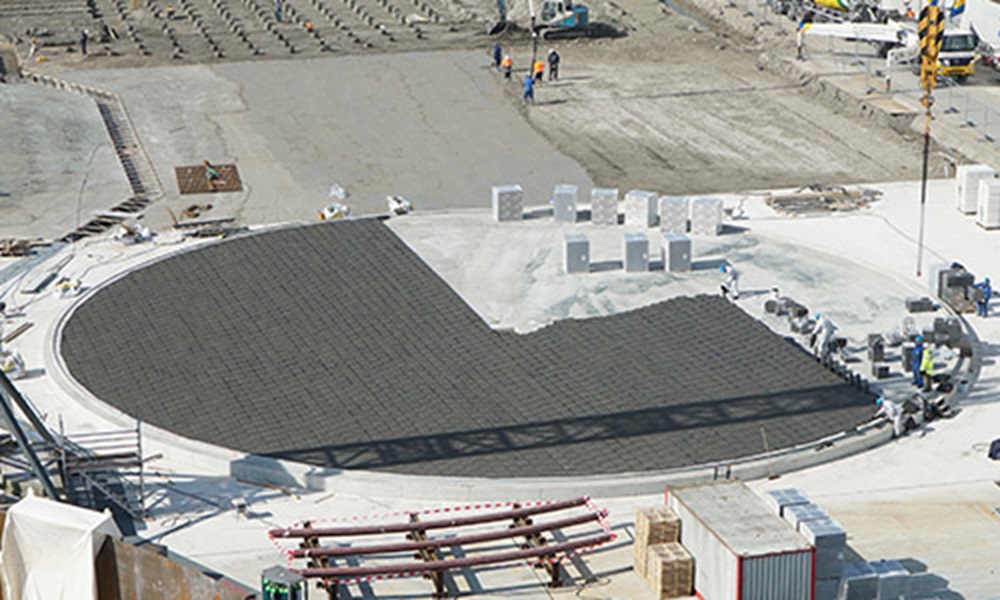
Storage tanks are used to hold a variety of organic liquids or gases including raw materials, intermediates, final products or usable byproducts. Tanks can vary in design and equipment, and the type of construction depends on the storage temperature and properties of the products being stored. A detailed assessment is necessary to ensure that all aspects are taken into consideration, so products can be stored and handled in the safest and most-efficient manner.
Energy Loss in Hot Storage Tanks
The growing worldwide demand for chemical products and proper storage and handling makes energy efficiency of storage tanks a key requirement. Each year, large amounts of energy are wasted due to hot storage tanks not having proper insulation systems in place.
With tanks that operate above ambient conditions, the tank walls and roofs are often viewed as the main sources of energy loss. However, the heat loss at tank walls and roof will fluctuate when the liquid level increases or decreases but the heat loss through the bottom will always remain constant. This can be explained by the fact that when the storage tank is only filled at 10 percent of its capacity, the tank bottom will always be in 100 percent contact with the hot liquid, making it the a very susceptible area for heat transfer and energy loss.
Energy loss has adverse effects on the tank’s operating costs but can also lead to issues related to the quality of the stored content. A decrease of temperature inside a hot storage tank can lead to an increase of viscosity or even product solidification. When minimizing operating costs and maintaining tank content quality are key requirements, a tank base insulation system should be specified for all tanks operating above ambient conditions.
Other Benefits of Insulating Tank Bases
In addition to reducing energy loss, a tank base insulation system has other benefits. Installing a tank base insulation system helps to protect the structural concrete base against the high temperatures of the tank content. This means that the reinforced concrete foundation can be installed more economically as less reinforcement may be required to reach the same mechanical performance.
It can also help protect the steel base structure of the tank against moisture which could lead to corrosion-related issues. Throughout its lifespan, a typical storage tank may be used for different purposes, or operate under cyclic temperatures, creating an environment where corrosion could become an issue if the tank is not properly insulated. Corrosion of the tank structure can compromise the mechanical integrity of the tank possibly leading to rupture in the steel bottom or subsidence of the tank walls. This can have a large economical impact by causing unscheduled shutdowns, damage the adjacent equipment and cause product contamination. It can also lead to a number of severe environmental and safety-related consequences such as compromised worker safety and possible pollution risks due to loss of containment.
Requirements for a tank base insulation material
It is important to consider using an insulation material that can withstand high loads suitable for tank base applications. Insufficient compressive strength can lead to settlement, loss of mechanical and thermal performance and consequently issues with the quality of the tank content.
It is important to choose a closed-cell insulation material that is resistant to moisture in liquid and vapor form. This will help to prevent uprising moisture from reaching the steel bottom of the tank and help to prevent the formation of corrosion.
Additional product characteristics that are often required are chemical resistance and incombustibility. These features help to increase overall worker safety around tanks in terms of chemical and fire exposure in the case of leakage.
FOAMGLAS® insulation tank base solutions
FOR ABOVE AMBIENT STORAGE TANKS
Since the 1960s, tank builders worldwide have been using FOAMGLAS® tank bottom insulation as the core component in their tank bottom insulation system.
FOAMGLAS® HLB (High Load Bearing) insulation systems, available in compressive strengths up to 240 kPa (348 lbs/in²), provide sufficient compressive strength for most common cylindrical tank designs requiring an insulated base. The closed cell structure of FOAMGLAS® insulation ensures that moisture and corrosion-related hazards are minimized. Leaks of hazardous substances or vapors do not affect the system as it is an inorganic material that protects against most possible forms of chemical attack.
The insulation value of FOAMGLAS® insulation does not change during its lifespan, which helps to ensure constant and lasting energy savings. In this way, the investment pays for itself in a short period of time and then yields constant energy and cost savings afterwards.
System BUILD-UP
A typical FOAMGLAS® insulation tank base system would consist of one or several layers of FOAMGLAS® high load bearing insulation blocks that would be adhered directly to the concrete or levelling screed with a dedicated PC® adhesive.
Depending on the storage temperature, a primer or cell filling powder can be specified between the levelling screed and insulation blocks. The FOAMGLAS® insulation shall be installed with the interleaving and capping material specified in our dedicated guide specifications for hot storage tank bases.
Finally, a layer of sand, oil-sand mix or sand asphalt mix is installed as levelling and pressure distribution layer between the insulation system and the steel tank bottom.
Payback Periods and Annual Yields
Tank builders and terminal owners can call on the expertise of Owens Corning’s technical services team to assist with the calculation of payback periods and annual yields of the investment in a FOAMGLAS® HLB insulation tank base insulation system.
These calculations consider all relevant factors such as temperatures and energy prices. For each project, heat lost through the base without insulation is calculated and compared with the total investment cost. This provides the total payback period of the investment in a FOAMGLAS® tank base insulation system, which may be a short as just a few months depending on the storage temperature of the contained liquid.
In addition, the total future yield of the investment is calculated for the active life of the tank with an insulated tank base. This shows the amount of energy saved per area of insulated tank base, and the total yield per year after the payback period.
Example of payback calculation for a hot storage tank base system consisting of 100 mm (3.93 in.) FOAMGLAS® HLB 800 insulation for a tank operating at 280 °C (536 °F).
- Average soil temperature at 1 m (3.28 ft) depth beneath the tank base plate is 10 °C (50 °F)
- FOAMGLAS® insulation type HLB, thickness 100 mm (3.93 in.), double layer
- Cost of investment and energy price have been estimated based on the average regional market information for similar project conditions
- Energy cost is €0.08/kWh ($0.10/kWh)
- Investment cost is €120/m² ($13.50/ft²)
- Details and dimensions of build-up of the tank base are based on the data that have been submitted for this particular project
Yearly average heat loss - uninsulated tank base: 263 W/m² (83 BTU/h.ft²)
Yearly average heat loss - insulated tank base: 70 W/m² (22 BTU/h.ft²)
Energy savings: €0.015/m².h ($0.13/ft².h)
Payback time: 7,792 hours
Payback period if the tank is in continuous service: 10.7 months
If the tank keeps functioning at this temperature during its 15 years active life, what has the yield of this investment been?
Cost of investment: €120/m² ($13.50/ft²)
Total energy savings: €2,030/m² ($230/ft²)
Yield per year: 20.8%/year
Net present value with a calculated IRR of 113%: €684,451 ($835,714)
Conclusion
With rising energy costs and an increased focus on energy efficiency and overall safety around tanks, it has become now almost unimaginable to not have a thermal tank base insulation system underneath above ambient and hot storage tanks.
A well-designed FOAMGLAS® insulation tank base insulation system will result in energy savings and lower operating costs in a relatively short payback period.
FOAMGLAS insulation systems will help protect the integrity of your tank against issues related to corrosion and chemical spills to help guarantee a longer tank life while increasing the worker safety around your tanks.


